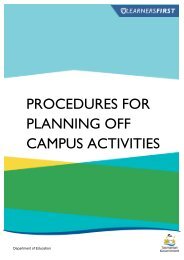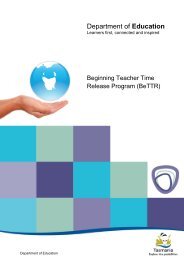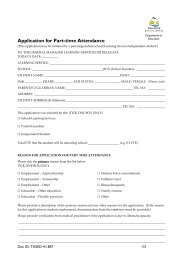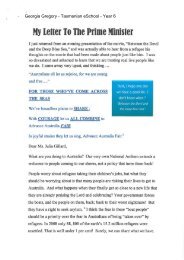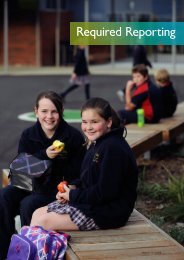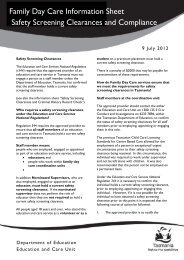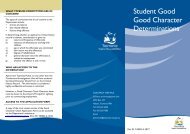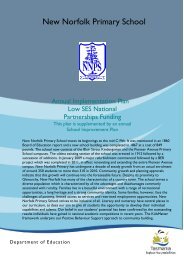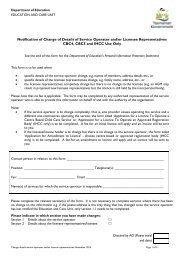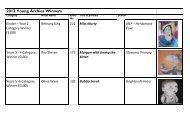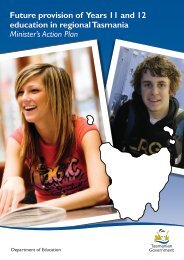The Frank MacDonald Memorial Prize
K Willis powerpoint - Department of Education
K Willis powerpoint - Department of Education
Create successful ePaper yourself
Turn your PDF publications into a flip-book with our unique Google optimized e-Paper software.
<strong>The</strong> <strong>Frank</strong> <strong>MacDonald</strong><br />
<strong>Memorial</strong> <strong>Prize</strong><br />
PowerPoint by Kathryn Willis<br />
Yolla District High School<br />
‘What do you understand by the term “Anzac Spirit?”<br />
How is it being demonstrated today in the Tasmanian<br />
community?’
<strong>The</strong> Anzac Spirit is in every Australian and New Zealander.<br />
You see it in everyday life. It is what you feel when times in<br />
life are at their worst and you think you can’t go on, then<br />
you get a feeling inside you that makes you say “yes I can”.<br />
It is what the Anzacs felt when they landed on the shore of<br />
Anzac Cove and were faced with towering sheer cliffs with<br />
heavy artillery firing from the cliffs at them. <strong>The</strong> Anzacs<br />
didn’t stop. <strong>The</strong>y kept on going and conquered the cliffs and<br />
kept on fighting.<br />
“ In drill we stand above all others,<br />
All the Germans and Turks can do their worst,<br />
But there’s nothing will daunt our brave Australians…”1
<strong>The</strong>re are many people from different generations who<br />
are a part of different communities. I wanted to touch<br />
on what they think the term “Anzac Spirit” means to<br />
them and show how they feel the spirit inside them.
<strong>The</strong> first is Mr Ross Smith. Mr Smith is a part of the Yolla Community. His father<br />
was an Anzac. I wanted to show his thoughts on the ‘Anzac Spirit’.
When a soldier became injured he always reassured his<br />
mates that he was going to be okay. <strong>The</strong> Anzacs always<br />
saw the good side of any incident.<br />
“… then comes a slow trickle of wounded- some dragging<br />
themselves painfully along; others being carried along on<br />
stretches. Bomb wounds all; a ceaseless, silent stream of bandages<br />
and blood. Yet three out of four of ‘the boys’ have grit left for a<br />
gay smile or a cherry little nod to their comrades…” 2
Second is Mr Nathan Dennis. Mr Dennis is a part of the Education Community. I<br />
wanted to show how he felt the “Anzac Spirit” when he endured his accident.
In the small town of Yolla there are many memorials<br />
for those who went to war.<br />
Even though Yolla has a small population of no more<br />
than a hundred they still show the spirit of the<br />
Anzacs.<br />
Sixty men went to the war and forty-five came back.<br />
<strong>The</strong> residents of Yolla made a memorial<br />
commemorating the soldiers that died and came<br />
back. <strong>The</strong> residents made two major memorials<br />
which still exist today.
<strong>The</strong> second was a memorial<br />
avenue which later became<br />
a grove.<br />
<strong>The</strong> first was a memorial hall<br />
built in 1922.
<strong>The</strong> <strong>Memorial</strong> Hall Today<br />
<strong>The</strong> residents made this because they wanted something that would stand for many years to come<br />
and that would be used by the ensuing generations. <strong>The</strong>y did it so the next generation would<br />
never forget what the sixty men did for us.<br />
<strong>The</strong> hall is still used today by the community for many events such as the annual Carols by<br />
Candlelight, sport and fundraising events.<br />
Honour Roll of those<br />
deceased<br />
Foundation Stone
<strong>The</strong> <strong>Memorial</strong> Hall Today<br />
<strong>The</strong> residents made this because they wanted something that would stand for many years to come<br />
and that would be used by the ensuing generations. <strong>The</strong>y did it so the next generation would<br />
never forget what the sixty men did for us.<br />
<strong>The</strong> hall is still used today by the community for many events such as the annual Carols by<br />
Candlelight, sport and fundraising events.<br />
Honour Roll of those<br />
deceased<br />
Foundation Stone
This is the Yolla Honour roll.<br />
Fifteen men died. Many of the<br />
men still have relatives living in<br />
the Yolla area today. Many of<br />
the men would be grandfathers<br />
or great grandfathers to the<br />
children going to the school.
World War 1<br />
soldiers.
Honour Roll of those<br />
deceased<br />
Foundation Stone
Building the hall was a community effort. A soldier from the community laid<br />
the foundation stone to show the appreciation to the community.
<strong>The</strong> second was an Avenue of Remembrance. Sixty<br />
trees were planted to represent the sixty men who<br />
went to war.<br />
Some years later the trees had to be removed so the<br />
road could be widened.
This is the road in to Yolla where the avenue would have been.<br />
<strong>The</strong> <strong>Memorial</strong> Grove
<strong>The</strong> community then made a Grove of Remembrance<br />
to replace the avenue.<br />
<strong>The</strong> grove, same as the avenue had sixty trees. <strong>The</strong><br />
trees include a tree from the Lone Pine at Gallipoli .
<strong>The</strong> Lone Pine
<strong>The</strong> Yolla community in only one small town on the<br />
North West Coast but there are many other towns that<br />
show the same spirit.
Wynyard<br />
Burnie<br />
Somerset
<strong>The</strong> Anzacs always had an eerie feeling of what was on the<br />
other side of the trench or hill. But they never showed fear<br />
when they looked over and fought for their lives. That is<br />
how we are able to face our doubts and fears because we<br />
get the spirit inside us that tells we can.
Penguin<br />
Ulverstone
We all acknowledge the soldiers and will always try to<br />
understand what they went through. Even if we never<br />
fully understand it, every Australian will always have<br />
something inside them that keeps them going and that<br />
is what I believe and call the ‘Anzac Spirit’.
Bibliography<br />
• 1- Anthony Hill, 2001, Soldier Boy, Penguin Books Australia. Battalion Song,(pg161)<br />
Printed on letterhead of the ‘SS Ulysses’. In the William collection (AWM PR 91/113)<br />
• 2- Les Carlyon, 2001, Gallipoli, Pan Macmillan Australia Pty Limited, Sydney.(pg296 ch16)<br />
Hamilton on life at Anzac: Hamilton,pp256-58.<br />
Pictures<br />
• Picture 1 on slide 1- www.wavingtheflag.com/ tour.asp?TourID=29<br />
• Picture 2 on slide 6- http://www.diggerhistory.info/pages-badges/rising_sun.htm<br />
• Picture 3 on slide 20- Yolla <strong>Memorial</strong> Hall Photo Collection<br />
• Picture 4 on slide 29- (AWM A04013) Gallipoli by Les Carlyon.<br />
• Written Statement Picture -<br />
http://www.education.tas.gov.au/frankmacdonald/background.htm<br />
Audio<br />
• Personal recorded interviews with Ross Smith, Nathan Dennis and Lauren Ewington.<br />
• Royal Military Collage Band, Duntroon, <strong>The</strong> Rouse, Anzac Day Remembrance Day,<br />
Commemorations Branch of the Department of Veterans’ Affairs, February 2003.<br />
Please click to end the slide.




